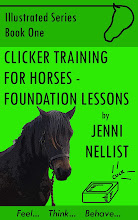I love it when both humans and their horses get to benefit from 'behaviour modification'. Fixing a problem so that both the owner and the horse feel rewarded is one of the most positive feelings I can ever get from my work.
One of the requirements for this is empathy towards the owner and horse from my part, and empathy towards the horse from his or her owner. Horses are at our mercy, and to help them our empathy must be as accurate as possible. That includes ditching human-centred values so the process can be pretty tough as simply recognising one is being human and not horse-centred can be hard enough! Knowing this warns me that I must not judge others before I've had a chance to walk in their shoes.
With empathy for horseness in mind, there are pretty much two ways of getting a horse to stop behaving in a way that hinders its human in trying to attain their specific goals with it. Either punish the horse for the 'misbehaviour'. Or alternately teach the horse that another, incompatible behaviour is more rewarding. The specific example I have in mind is in the retraining or behaviour modification of the horse that hates to be clipped.
For that horse, clipping is aversive, why else would the horse try to evade it? Clipping it successfully, i.e. the horse stands still enough for the duration, can be achieved by teaching the horse that moving away results in application of a pressure halter to stop it. This technique seems to be pretty popular according to the magazines. Responses to the pressure halter need to be trained in advance of using the clippers for maximum effect. Essentially the horse learns that it cannot escape the clippers because of the way the pressure halter prevents it from doing so. The horse may then either start to get used to the clippers. This is more likely if they are introduced in incremental stages and do not hurt, and the horse given respite for standing still for short periods. Or the horse may simply become even more fearful of them. This is exacerbated by the fact that the horse cannot use the option of 'flight' to reduce its fear, and this is especially likely if the horse was very scared of clippers rather just than slightly bothered, and if the increments in which the clippers are introduced were too large for that horse. This is the risk whenever response prevention techniques, i.e. trapping the horse, are used.
There is of course an alternative means of helping a horse get over its fear of clippers and increasing the calmer, still behaviour required to get the job done. Teaching the horse to associate the clippers with rewards such as food titbits can make it more likely to see clippers as something positive rather than something that has to be tolerated, or worse - endured because the horse is helpless to do otherwise. A horse might be set up to learn that if he sniffs at the switched off clippers, food treats will suddenly be made available, and then the task can be made gradually more difficult by turning the clippers on. Alternatively the noise of them played quietly in the background could become a signal for a bucket feed. He could also learn that when stroked with the hand, and then with the clippers (turned off of course to begin with) that food is then presented. Standing still to wait for the reward will then come more naturally and willingly. All this can be achieved without having to actually restrain the horse at all.
When the horse learns to stand to be clipped in the first manner, he has no choice, and probably won't perceive any reward in being clipped, just that if he keeps still the clippers will stop eventually. The human may however be quite satisfied. But when the horse is trained via the latter reward-based method, he gets rewarded as well as his human, so now who benefits?
Tuesday, 29 December 2009
Subscribe to:
Posts (Atom)

